Customs and international trade matters have played a prominent role in the headlines in recent months. The Trump administration’s pronouncements during this time have led to speculation and questions regarding the direction of many aspects of U.S. trade policy.
The Trump Trade Agenda
The Trump administration introduced its trade agenda back on March 1, 2017. Although specific details were sparse, the main theme in the agenda was that this administration would have a “more aggressive approach” to trade than former administrations. The agenda states that trade initiatives will be designed to increase economic growth, promote job creation, promote reciprocity with trading partners, strengthen the manufacturing base, strengthen our ability to defend ourselves, and expand our agricultural and services industry exports.
Based on these goals, the Trump administration established several trade policy priorities and identified vital areas of importance, including:
-
Strong enforcement of U.S. trade laws
-
Defense of U.S. national sovereignty in trade policy
-
Lowering trade deficits
-
Negotiation of new and better trade deals
-
Renegotiation of existing free trade agreements
-
Opening markets for U.S. exports
The administration has already taken steps to advance many of these priorities. In the following sections, we review the administration’s actions and accomplishments and highlight future activities to monitor.
Section 232 National Security Investigations
Consistent with campaign promises, the Trump administration has pursued an aggressive trade agenda to protect domestic industries. Earlier this year, President Trump issued a memorandum ordering the Secretary of Commerce to initiate two separate investigations and determine the effects of imported steel and imported aluminum on national security. The investigations were initiated under Section 232 of the Trade Expansion Act of 1962, as amended, and are proceeding on a substantially expedited schedule. Once the Department of Commerce (DOC) provides its report to President Trump, he will have 90 days to decide if he agrees with the findings and then 15 days to adjust imports of the article(s) or take any other non-trade related action. Potential remedies include, but are not limited to, tariffs, quotas, or tariff-rate quotas.
The Trump administration is employing the seldom-used Section 232 investigation mechanism because it believes that the usual trade remedy statutes, such as the antidumping and countervailing duty laws, are inadequate. The Section 232 procedure provides the Trump administration significant discretion in determining whether imports threaten national security, as well as in determining the appropriate trade remedies or non-trade related actions. Moreover, the 232 investigations enable the Trump administration to move forward with implementing its trade policy without Congressional authorization.
Although the DOC is expediting its investigation, there has been some interagency squabbling over whether the 232 mechanism is the correct mechanism to use to blunt the impact of imports. Moreover, some of the agencies, along with some members of Congress, believe that any Section 232 remedy would be a net negative for the U.S. economy and would invite retaliation by our trading partners.
Many in the domestic industry have blamed China for significant increases in imports. Specifically, the Trump administration has serious concerns regarding China’s over-capacity for steel and aluminum production and its potential to drive U.S. producers out of business. Although China may be the main target of this exercise, the Trump administration has also said that other countries are not trading fairly. As such, one of the big questions is whether any remedy adopted by the president will be all-encompassing, meaning covering imports from all countries, or whether certain countries will be exempt.
Finally, the scope of coverage remains unclear. Although the initial notices spoke in terms of steel and aluminum imports, it is unclear whether those terms include only primary forms of steel or aluminum, or whether they also include downstream products. At the hearings, many domestic industry participants requested that the administration include downstream products in any proposed relief. For example, in the aluminum 232 investigation, domestic producers requested that imports of aluminum extrusions be included in any relief. Domestic producers for downstream steel and aluminum products stated that if relief was provided only on primary steel and aluminum imports, countries—specifically China—would simply export the finished downstream product which, in turn, would make any relief inadequate.
Although it had been reported that proposed remedies for the steel 232 investigation may be released soon, President Trump said recently that the decision would be put on hold until work on other initiatives, such as health care, taxes and “maybe even infrastructure” has been completed. If President Trump waits until Congress acts on health care, taxes and “maybe even infrastructure,” then the delay could indeed be lengthy. Under a joint statement made at the G20 meeting earlier this month, the Organisation for Economic Co-operation and Development (OECD)’s Forum on Steel Excess Capacity is supposed to present a report in November. The administration’s delay could be aligned with the release of the OECD report to inform any potential decision.
The Future of U.S. Trade Deals
“Make America Great Again” was President Trump’s 2016 presidential campaign slogan. Since then, it has often been utilized by the administration to mean “Buy American, Hire American.” With such a nationalistic focus, many have wondered about the implications for trade ties with other countries, especially regarding Free Trade Agreements (FTAs). Following World War II, the desire to reshape and integrate the global economy gave rise to two primary forms of international trade agreements—multinational (or regional) agreements and bilateral agreements. While there are a variety of these agreements, with some being highly complex and others less intensive, they share the common goals of simplifying trade between nations, eliminating tariff and non-tariff barriers, and recognizing each other’s standards and regulations. Tariff and non-tariff barriers may take many shapes (duties, quotas, subsidies, import restrictions, customs delays or technical delays) and are essentially designed to protect local markets and industries. Today, the U.S. has 14 FTAs in place, most of which are bilateral (Australia, Bahrain, Chile, Colombia, Israel, Jordan, Korea, Morocco, Oman, Panama, Peru and Singapore), with two being multilateral (NAFTA and DR-CAFTA). The United States Trade Representative (USTR) Robert Lighthizer has stated that “for decades now, the United States has signed one major trade deal after another and … the results have often not lived up to expectations.” Read another way, the Trump administration does not believe that existing FTAs have enhanced economic growth, contributed favorably to the balance of trade, or strengthened the American manufacturing base. On April 29, 2017, the president signed an executive order directing the DOC and the USTR to conduct performance reviews of existing FTAs. While candidate Trump favored pulling out of existing trade deals and placing new ones on hold, as president, he has favored a “redo” and “modernization” of existing and future negotiations. Generally, the administration’s preference is for bilateral negotiations, but a multilateral FTA with the EU may still be in play. The president currently has Trade Promotion Authority (TPA) through next year that permits the administration to pursue fast-track negotiations of multilateral trade deals and submit them to Congress to approve or deny without amendment. This should come in handy for NAFTA renegotiations and multilateral negotiations with the EU, but the Trump administration may not need this tool to achieve its bilateral FTA goals. Although the current TPA expires on July 1, 2018, it is expected to be extended until 2021. The first trade deal to face remodeling is the North American Free Trade Agreement (NAFTA) (discussed in more detail below). Beyond NAFTA, there promises to be further trade negotiations and agreements with, for example, South Korea, Europe, India and Japan. Regarding Europe, there have been suggestions that the approach should be a hybrid of the forestalled Transatlantic Trade and Investment Partnership (TTIP) negotiations and a series of less ambitious sectoral agreements that could be concluded on a more timely and efficient basis. In contrast, the advancement of trade negotiations with South Korea, India and Japan may prove to be contentious and lengthy since all three are on the list of countries with significant trade deficits. Going forward, based on President Trump’s current position, the new standard for evaluating trade agreements will be to “determine whether they are working for America and whether the predicted results, in terms of jobs and economic growth, are being achieved.” The chart below summarizes the administration’s activities with current and prospective FTAs:
|
Agreement |
Member Parties |
Status and Timing |
|
KORUS |
United States |
Special session meeting requested by U.S. on July 12, 2017. Meeting is to be convened within 30 days unless the parties agree otherwise (i.e., by August 11). No meeting scheduled yet and Korea has asked to postpone the meeting until its new trade minister is appointed. |
|
NAFTA |
United States |
Renegotiation set to start on August 16, 2017. See details below. |
|
Other Existing U.S. FTAs |
Australia |
DOC and USTR ordered to conduct performance reviews of existing FTAs and provide a report of violations or abuses covering the following areas:
Reports are due at the end of October 2017. |
|
TTIP |
EU |
U.S. may resume talks on this multilateral agreement following the German federal election in September 2017. The USTR has recognized this as “an important negotiation for a variety of reasons.” |
|
TPP |
Australia |
U.S. withdrew from TPP in January 2017. The remaining countries are attempting to move forward without the U.S. Trump administration will likely pursue bilateral trade negotiations with “willing partners” in the Asia-Pacific region, such as Japan or Vietnam. |
|
U.S. – UK FTA |
United States |
Bilateral working group established to prepare the groundwork for a post-Brexit U.S.-UK FTA. Nothing official can happen until after the UK leaves the EU at end of March 2019. |
As the DOC and USTR work on reviewing, assessing and improving the U.S. trade agreements, U.S. companies should continue to closely monitor any changes, as tweaks to these agreements can impact the supply chain through changes in pricing and sourcing, regardless of whether the company directly benefits from the agreements as currently implemented.
Addressing the Trade Imbalance: Prospective Actions
One of the Trump administration’s primary objectives in revisiting existing trade agreements is to reduce the U.S. trade deficit. While past administrations have set a goal of reducing the overall U.S. trade deficit, Trump’s approach has been to shift away from the multilateral trade deficit and focus instead on reducing the bilateral trade deficit with each major U.S. trading partner. To this end, President Trump issued an executive order on March 31, 2017, requesting that DOC and the USTR present a report identifying those foreign trading partners with which the United States had a significant trade deficit in goods in 2016.
For each identified trading partner, the report is supposed to assess the major causes of the trade deficit, including various unfair trade practices and discriminatory policies, whether trading partners are imposing “unequal burdens” on U.S. commerce, and the effect of the trade relationship on employment and wage growth. According to press reports, the report focuses on China, Japan, Germany, Mexico, Ireland, Vietnam, Italy, South Korea, Malaysia, India, Thailand, France, Switzerland, Taiwan, Indonesia and Canada. Press coverage further indicates that, although it has not yet been made public, this report was submitted to President Trump at the end of June 2017 and is under review at the White House.
The emphasis on eliminating all significant bilateral trade deficits is already being reflected in the Trump administration’s preparation for trade negotiations. For example on July 17, 2017, when the USTR issued a summary of specific negotiating objectives for the upcoming negotiations to amend NAFTA, the first objective listed was to improve the U.S. trade balance and reduce the trade deficit with the NAFTA countries. This appears to be the first time ever that trade deficit reduction has been listed as an explicit goal of a trade agreement negotiation, as opposed to more general objectives such as reduction of trade barriers. This theme of reducing the U.S. trade deficit has been reiterated in other bilateral trade negotiations, such as the Comprehensive Economic Dialogue with China, and in the USTR’s request for a meeting with Korea regarding the U.S.-Korea Free Trade Agreement.
Although it is too early to tell whether these efforts at reducing trade deficits on a bilateral basis will bear fruit, importers should expect that U.S. trade negotiators will attempt to tackle the problem not only by expanding U.S. exports, but also by taking various steps, either negotiated or unilateral, to reduce imports from the targeted countries. At a minimum, importers should expect that the Trump administration will be particularly receptive to use of trade remedy laws, and even broader measures (such as Section 232 national security import restrictions), to achieve the goals of bilateral trade deficit reduction.
NAFTA Renegotiation
The renegotiation of NAFTA is set to begin on August 16, 2017, in Washington, D.C. The USTR recently published its list of renegotiation objectives, which we recently briefed you on here. While the stated goals of the renegotiation include a reduction of the trade deficit with Mexico and Canada, a modernization of NAFTA (which is now more than 20 years old), and an overall desire to position American business and industry in a more favorable position vis-à-vis its regional partners, the Trump administration has not provided many details on the proposed changes to the agreement that will lead to these outcomes.
For example, on rules of origin, the USTR has stated that its overall objective is to “[u]pdate and strengthen the rules of origin, as necessary, to ensure that the benefits of NAFTA go to products genuinely made in the United States and North America” and to “[e]nsure the rules of origin incentivize the sourcing of goods and materials from the United States and North America.” No details were provided as to whether the USTR’s negotiation priority will be to increase the Regional Value Content requirements for NAFTA qualification, or whether rules of origin will be streamlined to make the qualification process simpler.
Importantly, it is unclear how any changes to the NAFTA rules of origin would improve the trade deficit or position American businesses any differently, as rule of origin requirements usually treat material inputs from all member states equally. Any proposal that would seek to increase U.S. content alone would likely face strong opposition from Mexico and Canada, but could lead to creative reengineering of the rules of origin. Of course, this type of manipulation of the rules of origin would defeat one of the expected goals of the renegotiation, which is to simplify the NAFTA qualification process to make it more accessible to small and medium-sized companies.
It has been reported recently that the NAFTA renegotiations will be held in seven rounds, spaced at three-week intervals. Accounting for some delay due to the holidays, this schedule would result in the renegotiations concluding in late January or early February. Many have speculated that this aggressive timeline is intended to conclude negotiations well in advance of the Mexican presidential election in July 2018. While the prompt conclusion of the renegotiations could help avoid political interference in the process, many have questioned exactly how many of the U.S. priorities can be favorably renegotiated in just over five months. We will be following the NAFTA renegotiations closely and will report on important developments as they occur.
Enforce and Protect Act of 2015
While much of the attention recently has been on multilateral and bilateral free trade agreements, the Trump administration has also been ramping up efforts to address trade concerns at home through U.S. Customs and Border Protection’s (CBP) enforcement powers. CBP is increasing enforcement under the Trade Facilitation and Trade Enforcement Act of 2015 (aka the Enforce and Protect Act or EAPA), which was signed into law in February 2016. With more domestic parties petitioning to initiate EAPA proceedings, CBP has increased its investigations of potential evasion of antidumping (AD) and countervailing duty (CVD) orders. EAPA allows CBP to lead AD/CVD evasion investigations (as opposed to DOC) in an effort to increase enforcement efforts.
Importers receiving a CBP Request for Information (CBP Form 28) should carefully evaluate the implications of the requested information. CBP’s requests are often the first step in evaluating potential AD/CVD evasion under EAPA, or may be a prelude to other civil penalty enforcement. Under the EAPA regulatory guidelines, CBP has only 90 calendar days in which to reach a determination of “reasonable suspicion of evasion” and issue interim measures to address potential AD/CVD evasion. A failure to timely respond to CBP Form 28 or an insufficient response could result in a finding of adverse inferences under EAPA and may trigger interim measures that may not only require the deposit of AD/CVD on subsequent shipments, but will also trigger CBP’s actions to amend unliquidated entries requiring the deposit of AD/CVD. Moreover, remedies under EAPA are not exclusive and vague or unsupported responses may trigger other available remedies, such as civil penalty actions under 19 U.S.C. § 1592, or potential criminal penalties.
The bottom line is that importers should carefully evaluate inquiries from CBP requesting information or confirming country of origin, product descriptions or tariff classifications prior to responding, and importers should work to ensure there are no broader import compliance concerns. Where systemic or material errors are identified, a voluntary disclosure may be appropriate prior to responding to CBP’s inquiries. The failure to timely comply with CBP’s requests for information could result in a finding of adverse inferences under EAPA and the implementation of interim measures, as well as the potential assessment of civil or criminal penalties.
Centers of Excellence and Expertise: Increased Enforcement and Targeting
Beyond increased enforcement of AD/CVD actions by CBP, the agency recently completed a restructuring designed to better serve the trade and enhance CBP’s targeting and enforcement activities. Rather than managing trade compliance through individual ports of entry, CBP now manages most post-entry issues through 10 Centers of Excellence and Expertise (CEEs) organized by industry, including Agriculture & Prepared Products; Apparel, Footwear & Textiles; Automotive & Aerospace; Base Metals; Consumer Products & Mass Merchandising; Electronics; Industrial & Manufacturing Materials; Machinery; Petroleum, Natural Gas & Minerals; and Pharmaceuticals, Health & Chemicals.
While the CEE restructuring provides more consistent national treatment and a centralized location for importers to coordinate inquiries and manage inconsistent port treatment, the consolidation has made targeting and enforcement more transparent to CBP. The CEEs are able to focus on specific issues and target importers in those industries more directly. Moreover, the consolidation of industries has enabled the CEEs to identify best practices among importers and readily identify similarly situated importers who may be failing to comply with the import laws, or who are in areas with elevated trade compliance risks.
Since CBP’s restructuring, many importers have seen a dramatic increase in agency activity, including formal Requests for Information and Notices of Action (CBP Form 29). CBP is broadly analyzing trade compliance, with emphasis on AD/CVD compliance and duty preference program qualification. Importers should ensure that due diligence is completed by knowledgeable trade compliance or legal counsel prior to responding to CBP, and ensure that processes to route all formal CBP requests to appropriate team members are established since all CBP inquiries have established response deadlines. The CEEs are also increasingly pursuing informal communication channels, such as email requests or customs broker inquiries, and importers would be wise to approach any response, formal or informal, very carefully, as any false statement or misunderstanding could result in increased enforcement activity.









 i
i

